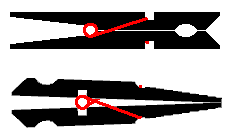Tips and Tricks |
Tools and MaterialsModel Making Tools and MaterialsAlways use a sharp blade for cutting but keep some old ones around for jobs like scraping off mould lines.A useful multi-function tool can be made by drilling a small hole into the end of a piece of dowel and using epoxy to fix a darning needle into it. An old, empty ballpoint pen is a good tool for scoring fold lines and 'embossing' detail onto paper and card. Keep one (somehow there's never one around when you need one and loads of them when you don't) specially for the purpose, but keep it away from your working pens otherwise you'll be pretty much guaranteed to pick it up each time you reach for one of them. Finger nail filing boards have their uses but you can make your own equivalents in a wider range of grits by glueing sandpaper to iced lollipop sticks. The circular saw on a motor tool will cut plastic less aggressively if you mount it in reverse. A 40w or 60w light bulb can be used to melt sprue and is potentially less dangerous and messy than a naked flame. Bottle tops make handy, disposable pallets for small amounts of paint, glue, etc and can be fixed securely to the worktop while in use with a blob of blue-tack. (Be sure to drink the beer after removing the bottle top or it is likely to go flat).
35mm film canisters can be very useful both for storing small parts and the short term storage of small quantities of thinned/mixed paint. Aluminium foil with small depressions in it makes a handy disposable paint pallet. Make a 'tent' using the plastic film that dry cleaners cover garmets with to place over freshly painted models to stop dust landing on them while they dry. Thin wire (which comes on reels) and stretched sprue can be straightened by attaching a weight to one end and hanging it from a suitable location for a few days.
It's possible to cast small parts from melted sprue. The spru should be cut into small pieces, to aid melting, and can then be melted over a flame. If the mould is made from aluminium foil, the spure can be heated in the actual mould. Another option is to heat the sprue using a copper end cap from a plumbers merchants as a crucible. The key thing here is to heat the sprue gently to avoid bubbling and to be very careful to avoid breathing in dangerous fumes. Thin paper, such as cigarette paper, is easier to cut without tearing if it's sandwiched between two sheets of ordinary paper first. If you need a heavy ballast weight, say in the nose of an aircraft, and don't have a lot of space, consider making a custom lead weight: Start by cramming (not so tight you can't remove it) aluminium foil into the nose cone. Remove it and use it to make an impression in some damp sand. Now fill the hole in the sand with molten lead. (You can melt lead pellets over a candle flame in an old spoon). Every time you read anything instructions about trimming the waste off kit parts, the author tells you to 'always cut away from yourself'. So do you? Probably not because in this operation you get an awful lot more control over the knife pulling it in the opposite direction. This of course puts your thumb in jeopardy. Two things you can do:
The cardboard from which breakfast cerial boxes are made is generally of a remarkably good quality. This article is copyright (C) Andy Slater and is used here with permission |
|
|
Copyright (C) Webspace Ltd All rights reserved. |
||

 Hair
grips, clothes pegs and Bulldog clips make useful clamps. With the
spring type clips it is possible to 'reverse' them to make a different
type of clamp.
Hair
grips, clothes pegs and Bulldog clips make useful clamps. With the
spring type clips it is possible to 'reverse' them to make a different
type of clamp.